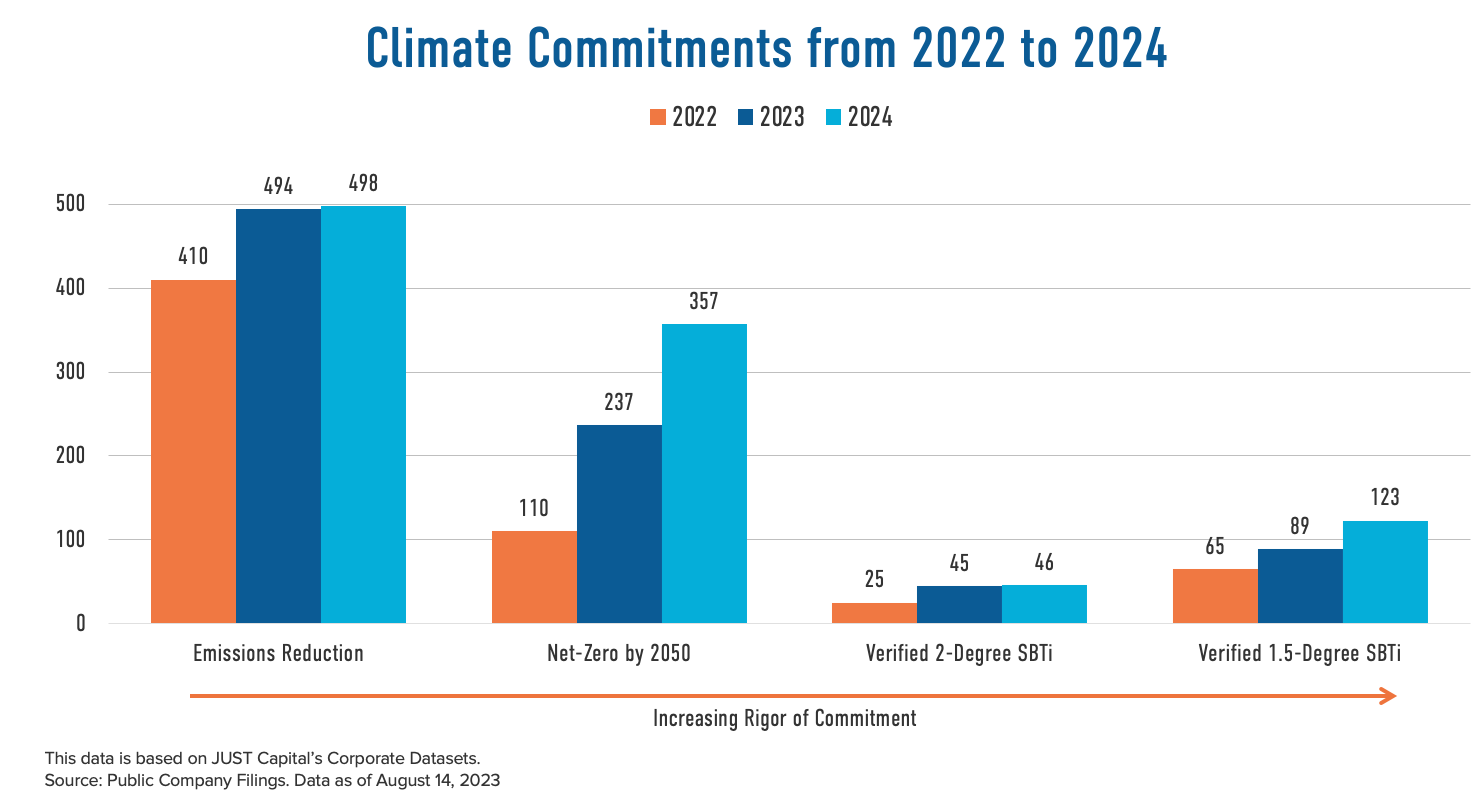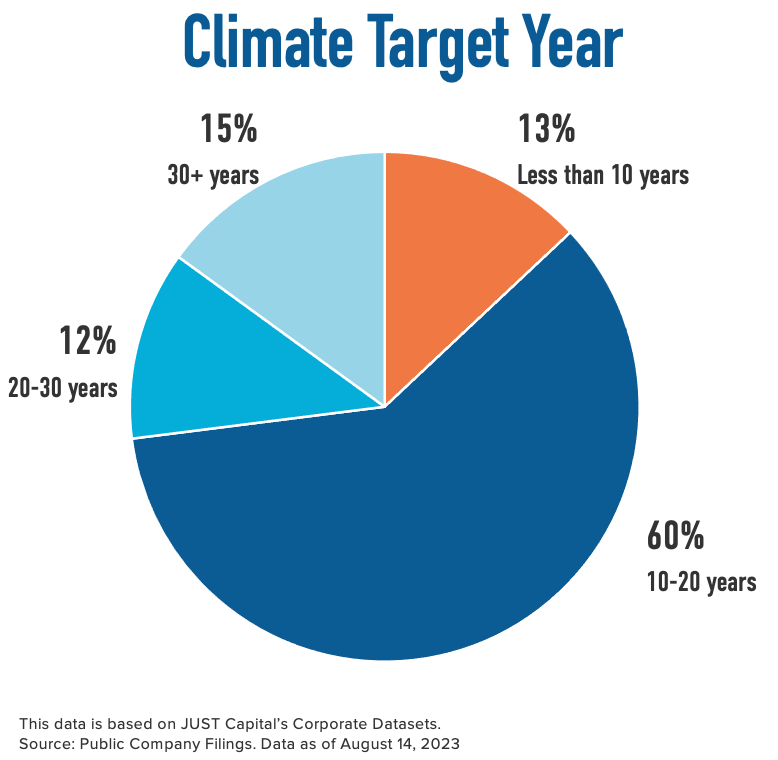JUST Report
Net-Zero Commitments Have Tripled In the Last 3 Years – But Actual Emissions Reductions Are Lagging
- More Reports
- View all JUST Reports

(Image via Getty Images)
This report was written by Laura Thornton, Senior Manager of Environment at JUST Capital, and Shannon Cabral, Research Analyst at JUST Capital.
When it comes to climate action, new data on America’s largest companies reveals mixed results.
JUST Capital’s latest analysis of Russell 1000 climate commitments and emission data shows real progress on long-term pledges – more CEOs are promising action over the next few decades. But there’s been less progress on actual emissions reductions over the last few years.
The data serves as a crucial discussion point for business and policy leaders ahead of Climate Week, which draws business, government and civil leaders to the UN General Assembly’s convening on climate issues.
Analyzing public disclosures from the Russell 1000 as of August 14, 2023, JUST Capital found inspiring news: commitments are growing. The bad news? Emissions are not always following suit.
As part of our Rankings of America’s Most JUST Companies, we monitor, track, and analyze corporate climate commitments across 37 industries. Our analysis centers around four categories, listed in order of increasing rigor:
- General emissions reduction commitments (or overall promises to cut emissions without setting a specific time frame or goal)
- Pledges to be Net-Zero by 2050 (reducing emissions as much as possible by 2050, and then offsetting the remainder that cannot be abated),
- Verified Science-Based Target Initiative (SBTi) for 2 Degree Scenario
- And lastly, Verified SBTi for 1.5 Degree Scenario.
Over the course of three years of measurement, we have seen an increase in every category of commitment – a hopeful sign for corporate action on climate issues. Net-Zero commitments have tripled, and our most rigorous category, Verified 1.5-Degree SBTi has doubled since the start of our measurement.
The increase, albeit small, in two categories, Emissions Reduction and Verified 2-Degree SBTi, could be attributed to a number of factors. Emissions reduction commitments are simple time-bound statements with a specific amount of committed reduction. With a push for more action on climate, we see companies increasing the rigor of their commitments by expanding their scope, shortening their time horizon, or attaining scientific verification of their goals. 2-degree SBTi commitments are being phased out, which explains their stagnant growth. Industries with the greatest increases of commitments include Industrial Goods, Software, and Commercial Support Services industries.

Despite the promising growth across these categories, corporate action on reducing actual emissions is lagging overall – signaling the need for more urgency around this issue.
In exploring which companies are in fact making real change, there were a few key takeaways. It is a fair assumption that companies most likely to be reducing emissions are the ones with more robust targets, while less rigorous commitments yield less reductions. We see this in action with companies that have committed to science-based targets – which have reduced their emissions the most over the past year.
26 of 123 with the most robust targets disclosed an actual reduction of emissions in the past year. Unfortunately, companies with a general commitment to reducing emissions (e.g. reduce 50% by 2045) or Net-Zero climate commitments have, on average, increased their emissions. This further supports the need for verified science-based commitments, as unverified commitments lack the accountability mechanism to drive meaningful change across a company’s sustainability strategy when there are external parties involved in the construction and progress of these goals.
Climate commitments are more than just a singular statement, there are many underlying details that inform the strategy and pathway to a company’s public goals. This is how we begin to see if companies are really walking the walk or sparking concerns around greenwashing.
More than half of Russell 1000 companies are aiming to complete their reductions in the next 10-20 years, with the average target year being 2034. With 2050 being the absolute deadline to achieve Net-Zero to meet a 1.5 degree warming scenario, one hopes that the majority of companies are committing to an earlier deadline. Or if companies need the full amount of time to achieve reductions, they can set targets to achieve a portion of their overall reductions before the final target year, known as interim targets, to show their dedication to achieving their stated goals.
That said, among companies with Net-Zero commitments, only 11.48% have publicly set interim targets. This will be a key space to watch as time goes on and more aspects of these commitments get put into action and monitored by customers and investors alike.

This year, we also began tracking SBTi’s latest category of commitment – a verified Net-Zero target – for the first time, which 115 companies have committed to. We see the most of these disclosures in the Software and Commercial Support Services industries. The increasing amount of avenues for companies to verify the scientific accuracy of their commitments is a sign that companies value progress and integrity in this currently unregulated space, especially in a time where concerns of greenwashing are high.

Looking ahead, business leaders can turn their attention to making more aggressive commitments by understanding the approach of industry peers and providing details on how and when they will achieve each portion of their commitments.
We are entering a transition between celebrating commitments and holding companies accountable to them by measuring action, and it will be telling who steps out to the front of the pack.
To unpack your company’s environmental performance in the 2023 Rankings and gain insights into how to improve on core climate issues, please reach out to corpengage@justcapital.com.